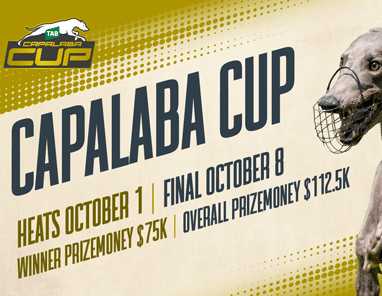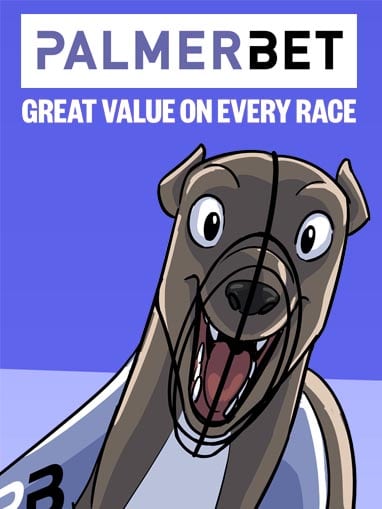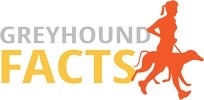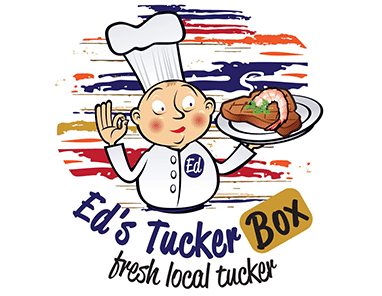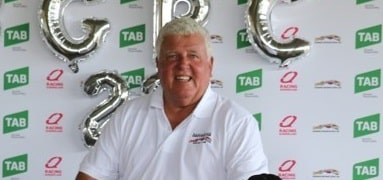
By MIKE HILL
ROBERT Ayres seems to have knack of getting the best out of his dogs.
The Glass House Mountains-based trainer proved it again recently when he produced Group performer Lucky Lance to win the $10,000 Open Sprint over the shorter 331m at Albion Park.
Lucky Lance was coming off a series of 500m runs, including a second in the G3 Darwin Cup (537m) in late July, an unplaced heat run in the G3 Townsville Cup (498m) series in early September and a string of 520m races in Brisbane.
“I’m a strong believer in class comes to the top,” he said.
Ayres let it slip that ‘a few’ had said to him he was mad for putting Lucky Lance up against the short-course speedsters.
“But the dog proved me right,” he said.
Lucky Lance powered past pacesetter Hope Sure Can in the straight to push his career record to 21 wins and 23 placings from 68 starts and lift his prizemoney to just under $117,500.
He then won again a week later in a 3rd/4th Grade at Albion Park over 520m leading all the way in a slick 29.89s.
However, late last month (October) tragedy struck when Lucky Lance suffered a broken hock in a heat of an Open sprint over 395m at Albion Park.
“It’s unlikely he’ll race again,” his trainer said.
“This type of injury has happened to me four times over the years and always to good dogs.”
Ayres, who is in his second reincarnation as a trainer, is featured in this month’s The Trainer column.
He said he rugged up his first ever winner – a black bitch called Ginnie Bint – at Melbourne’s Sandown Park in 1972.
“I was living in Melbourne. I was 20 at the time and training dogs for a guy called Spencer Wright who lived around the corner in Oakleigh,” Ayres said.
“He had some good dogs, but he was a returned serviceman and unable to walk them, so I took on the training duties.
“Spencer loved his dogs and he was very good with greyhounds.
“I didn’t know much at the time and did whatever he said.
“We had success and winners at Sandown in the few years I was involved.
“I gave training away and got married.”
Ayres moved to Queensland in 1993, settling in the Brisbane Bay area of Wynnum-Manly, and returned to greyhounds as an owner just before 2000.
He bought a dog called Major Trumps from Billy Northfield and formed a syndicate with some mates at the Manly Bowls Club.
Under the guidance of Rusty Dillon, Major Trumps became a Capalaba specialist winning 10 races up the straight track and claiming the club’s greyhound of the year title in 2001.
The son of Head Honcho also won the NZ Challenge at the Gold Coast’s Parklands complex in 2002, qualifying for a spot in the Auckland Cup where he finished fifth.
He ended his career with a record of 21 wins and 24 placings from 65 starts.
Ayres said he was lucky enough to receive the bitch Anniston (Fortified Speed-Goddess Of Fire) from leading Victorian breeder Kevin Burns, of Awesome Assassin fame.
He had previously bought the bitch Bonfire, which he raced with his bowling mates, and several pups from Burns.
The breeder said he had a bitch he wasn’t sure what to do with and asked Ayres if he’d like to take her.
“That’s how I got Anniston,” he said, never realising the impact she was going to have on the industry in later years.
One of her offspring from a Knockabout Wok mating was secured by Reg Kay. The bitch later raced as Oriental Angel and as a broodbitch produced the wonderful littermates Knocka Norris and Elite Oriental from an Elite State mating.
Two super stars of the track and current sires in demand – Aston Dee Bee and Aston Rupee – trace their maternal lines back to Anniston through an Elite Oriental daughter and grand-daughter.
Ayres also has a close association with Victorian owner-breeder-trainer Gavin Kearns.
“We’ve been in partnership in dogs for about 15 years,” he said.
“At the moment we share a couple of greyhounds.
“It’s a good relationship; we talk several times a week.”
Ayres said he started training again when he and Kearns bred a litter by Cosmic Rumble from the bitch Hot Dream in 2017.
“I got two pups – a dog and a bitch. The dog Steamy Night was all right, but the bitch Warm Feeling wasn’t much,” the trainer said.
He moved from Manly to Wurtulla on the Sunshine Coast just north of Caloundra in 2013 before settling on a one-and-a-half-acre property at the Glass House Mountains in 2020.
Since returning to the lead and collar, he’s had exceptional success with his small team.
“I’ve got room for only five dogs,” he said.
And he seems to find the best in most, just like the well-bred Boscono, who retired just over 12 months ago.
He purchased the My Bro Fabio-Beauty Bale bitch, which at the time had a record of one win from 11 Victorian starts – for $8000 in mid-2019.
Under Ayres’ guidance Boscono developed into an extremely good, versatile chaser winning at Capalaba, Albion Park, Bundaberg, Maitland, Casino and Wentworth Park from 311m to 600m.
She finished her racing career with 22 wins and 23 placings from 69 starts and prizemoney just under $82,000.
The trainer now hopes she can become his foundation broodbitch.
Pups from her first litter to Bewildering are turning one year old this month and Ayres has his fingers crossed there’s a champion or two among them.
From a litter of 11 eight survived ‘and they have gone to friends and mates’.
“I’ve got a third share in four on them and I’ve kept one pup for my wife,” he said.
And as with Boscono, Ayres has had huge success with both Lucky Lance and I’m Explosive in the past 18 months.
I’m Explosive joined his kennels in April last year still a maiden after 10 NSW starts and in just over 12 months had risen to Group class with 18 wins and 21 placings (57 starts) and prizemoney just over $122,000.
He said he had relied on knowledge and advice from Kevin Burns, who pointed him in the right direction when he purchased Boscono, while he also has a good association with Andy Lord, of She’s A Pearl fame.
“Gavin Kearns and I bought Lucky Lance off Andy in March 2021 after the dog had finished third in a maiden at Temora,” Ayres said.
“Andy has been a good contact for us. He’s been good to me. I find him a straight shooter. I like him.”
Ayres said he was a great believer in walking dogs.
“I walk them every day on the lead – in the mornings for 30 minutes and shorter at night – and they go on the machine every second day,” he said.
He believes walking outdoors with a change of scenery is a big plus for dogs. ‘They’re seeing and hearing something different all the time.’
And going on his results, his philosophy obviously works.
1: How and when did you get involved in greyhound racing?
A: At primary school age we had greyhounds in the backyard for two years, but it wasn’t until a football injury at 17 and I was advised to do a lot of walking that I started to handle the dogs.
2: Who has been the greatest influence on you as a trainer?
A: Many trainers of my dogs but Bill Northfield left the greatest impression on me. He said to me: ‘Get them fit, Robert. I can tell you that I’ve never won any money racing in a trial, but I’ve won a lot of money trialling in a race’.
3: At what age do you start preparing a pup for racing?
A: When they’re 16-18 months old.
4: How long does it take to prepare a pup for its first race?
A: About three months, depending on the dog.
5: What makes a good pup?
A: They should show you something in their preparation. They are generally smart, learn easily, tenacious and have speed.
6: Do you do anything special when preparing a young dog for its maiden compared to a seasoned performer?
A: The preparation is in the chasing and therefore trialling up a straight and around a bend is the foundation of a good chaser.
7: Do you have a set routine for all your greyhounds or do you vary training for individual runners?
A: All my dogs have the same routine with walking and feeding. Free galloping for all but some have more than others depending on the individual.
8: Do you have any unique or unusual methods you would like to share in regard to training?
A: Not really. I vary their walks and free galloping areas when possible.
9: Do you swim your dogs as part of your training regime?
A: Not now. I used to when I lived near the sea for rehab work.
10: How frequently do you like to race your dogs?
A: Generally weekly.
11: What’s your training routine for dogs between races?
A: Free galloping or a run where they can hang on to the lure or teaser.
12: Do you do all muscle work on your dogs and treat all injuries?
A: I try but since I am not good at it, I nearly always call on an expert – a muscleman.
13: Do you do treat all injuries to your dogs yourself?
A: I do the massage, ultrasound and first aid work but heavily rely on the experts to find the sore spots.
14: Which is the best greyhound you have trained?
A: Chapel Road whelped 1965 (Fawn Scout-Brocatel) brother to Lord Baden. Broke the track record at Wentworth Park in a trial. Stood on a piece of glass and severed all the tendons etc in his foot. Never raced again.
15: What do you consider is the best greyhound track in Australia and why?
A: I haven’t been everywhere, but to me Maitland and Warragul are at the forefront. Big tracks with a wide sweeping bend into the straight. Box draws and corner starts are less favourable to the result.
16: What does the industry need most going forward?
A: Veterinary centres for greyhounds. The $10 afforded to owners and trainers for racing a dog could be used to facilitate the treatment of all greyhounds. Set up centres where vaccinations, pharmaceutical products, injury treatment etc. are available to all microchipped greyhounds at a discount price – a non-profit welfare benefit for all participants in the industry. Also a national grading system.
17: What is the best advice you could give someone just starting out as a trainer?
Get into a set routine with your dogs. Ask questions especially from the leading trainers such as the Zammits, the Elsons, Tony Brett, Tony Apap, Tom Tzouvelis, Ray and Mary Burman, Ned Snow etc. and many others. They are all great people in the industry and are very willing to help anyone. Just go ahead and ASK.



